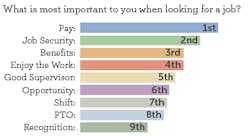We at ResourceMFG recently conducted the first of what will be an annual Manufacturing Employee Opinion Survey. Nearly 2,500 hundred people in manufacturing—working for ResourceMFG, for our clients, or actively in the job market—completed the survey. The group represents a wide range of skill sets and geography. We believe it might be the largest survey of its kind ever done.
In our first article in this series, we outline the reasons for undertaking this project, and the valuable insight into workforce issues we are seeking for our company and our clients.
In this article, we focus on the number one subject of importance to the hourly manufacturing employee according to the survey: pay rate. Or, more specifically: fair, competitive pay. See our bar graph from the survey below. It summarizes the answer to this question:
For some, the finding may not be especially intuitive. Of course, job security (ranked #2), good benefits (#3), and other factors are important to today’s employees; long term workforce retention and engagement is, of course, multi-faceted.
But, on further study, the importance of pay becomes self-evident. So many manufacturing employees have ‘entry-level’ skills, or experience in semi-skilled positions (for example, machine setup/operators or electro-mechanical assemblers). Depending on the market and position, pay rates for these jobs can range from $10.00 (or below) per hour up to $15.00.
For many, these pay rates are challenging, to say the least. They live from paycheck to paycheck, and often have dependents. ‘Job One’ is getting as much money in the paycheck as possible up front to make ends meet.
As a result, hard choices are often made. Some examples:
- Next to layoffs, the #1 reason those surveyed left their last job? “Found a new job that paid more money.”
- 27.8% would move to a less desirable shift for $1.00 or more per hour, according to the survey results.
- 39.6% of those surveyed do not have health insurance.
And external factors compound the issue. For example, since 2005, the cost of living has risen over four times (up 35.5%) the rate of manufacturing wage increases (up only 7.4%).
So, more often than not, our advice to our manufacturing clients is this: set the wage rate as fairly and competitively as possible from day one. It is the most important factor to this vital part of their operation: the workforce
Look for our next article in this series. We will cover what insights the ResourceMFG survey sheds on shift differentials, turnover, retention, and other topics.
About the Author
Keith Wisner
Vice President, Supply Chain Analytics
Keith Wisner is Vice President of Supply Chain Analytics at EmployBridge, the largest light industrial staffing company in North America. It includes a portfolio of supply chain workforce solutions specialty companies: ResourceMFG (manufacturing), ProLogistix (warehousing and distribution), ProDrivers (trucking) and Select (light industrial).
Keith has helped companies in the supply chain with workforce staffing and strategy since 1991 in roles that include service delivery, marketing, brand development and analytics.
A New York native and long-time Boulder County, Color., resident, Keith lives on a little bit of land with his wife and near his two grown children. He can be reached at [email protected] or at 720-889-9722.

